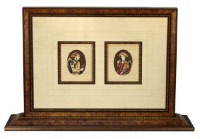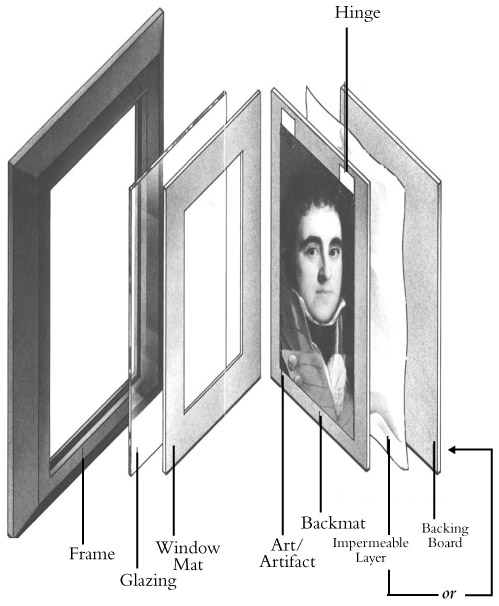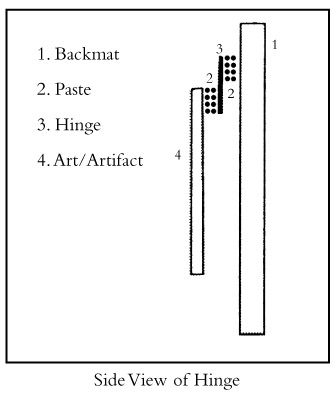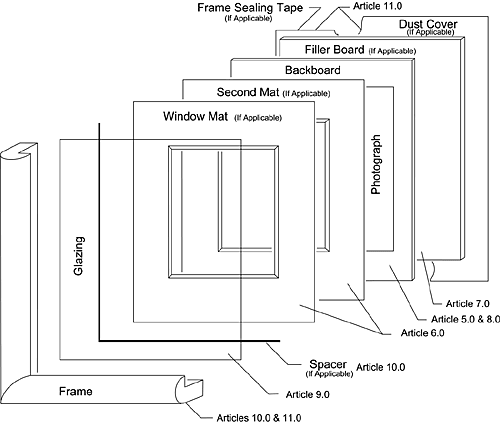Art Custom Framing Gallery Los Cabo San Lucas, San Jose del Cabo, Mexico

 |
What is in your frame and how it is constructed. The part you do not see is the most import part for preservation and longevity.
Rely on the best Fine Art Custom Picture Framing Gallery in Los Cabos. Two locations Cabo San Lucas and San Jose del Cabo. Offering the largest variety of quality Frames and matting


Introduction
This Standard Guide was developed by GAFP (Generally Accepted Framing Practices Committee) for use when framing artwork that is, or may become, valuable. Either monetarily, or for historic, collector, or sentimental purposes. This document provides the guides for minimum preservation when framing artwork of any kind.
General Considerations
To accommodate the wishes of the client, availability of materials and/or required techniques, articles of this standard guide may be altered, and these exceptions shall be noted.
The articles in this guide cannot guarantee results in any individual case, but are recommendations based upon relevant research and consensus of the GAFP committee. It is the responsibility of the framer to recognize when an individual item of artwork may require special procedures and/or treatments, not covered by this standard. In such cases, appropriate information shall be obtained before any framing procedure is attempted. When indicated, the framer shall make a referral to a specially qualified professional, such as a conservator.
Factors Influencing Framing
Preservation framing is not a conservation treatment for any item or artwork. Its objective is to create a non-invasive environment. For preservation framing to be of minimum value, the artwork or item should be in good condition prior to framing.
When the item to be framed is in poor condition, conservation should be considered. Serious questions considering the condition of the item, and the appropriateness of framing it in that condition, should be referred to a conservator before framing.
Some of the common problems that should be addressed by a conservator are:
3.03.1 Inherent problems in the materials or techniques used.
3.03.2 Mold and/or insect infestation.
3.03.3 Support problems.
3.03.4 Unfavorable display and/or environmental conditions.
3.03.5 Use of improper materials and/or techniques in framing.
3.03.6 Neglect.
Terminology
Definitions—"FACTS Standard Terminology," (latest chapter or revision) and Random House Webster's Unabridged Dictionary, Second Edition.
Format—The following words are defined to clarify the importance of the articles, sections or formats, and to identify those that are mandatory.
"Shall"—indicates that a provision is mandatory.
"Should"—indicates that a provision is recommended as good practice.
"May"—indicates that a provision is optional.
"GAFP"—Generally Accepted Framing Practice
"Consensus"—a majority of opinion.
"Material permanence"— shall be determined by ANSI/NISO 39.48 1992 and/or FACTS Guide for Permanence in Paper Mat and Mount Boards 2000 (or latest revision).
"Procedures"—all work done during the framing process.
"Safe for artwork"—shall mean that there are no known effects, or known harmful effects, or shall have been proven to be safe for use in framing of the artwork or item.
"Stable"— subject to minimal change physically, optically and chemically.
"Item or Artwork"—anything to be framed.
"Glazing"—includes both glass and plastic.
"Art On Paper"—original artwork as well as reproductions.
"Photography"—all types of original photographs as well as photographic reproductions.
"Textiles"—all types of fabric artwork.
Materials & Procedures
All materials and procedures performed shall meet those set forth herein, or, if not set forth herein, be generally considered safe for the item or artwork.
All procedures that include attachment to the artwork shall be reversible without damage to either the artwork or its support.
All attachments to the item shall be removable without damage to the item or its support.
All layout and dimensional markings in areas that would contact artwork shall be made with a removable medium, and shall be removed.
Artwork shall be completely separated and isolated from any potentially damaging materials by an impermeable barrier such as glass or metal.
Some photography, textiles and some other artworks may require non-alkaline materials.
Matboard and Decorative Embellishments
All matboard materials including colors shall meet Standards Article 4.05.
All fabrics, mounting adhesives, decorative embellishments, and any other materials used shall be safe for the item.
All paints and inks shall be non-bleed and non-migrating.
Matboard of any thickness shall not be considered a barrier from potentially damaging materials.
Backboards and Filler Boards
All materials, including colors, shall meet Standards Article 4.05.
A backboard shall be of sufficient thickness and rigidity to maintain a flat, environmentally stable surface.
Attachment to Artwork and Items
All attachments shall be removable without damage to the artwork, item or its support. (Standards Articles 5.02, 5.03.)
Textile mounting shall place a minimum of physical stress on the fibers and the stress shall be evenly distributed.
Textiles shall not be mounted with adhesives.
Glazing
Items that require a protective glazing shall meet FACTS "minimum Preservation Glazing Standard 2000" for blockage of ultraviolet light.
Spacing
All artwork shall be separated from the glazing by window mat(s) and/or spacer(s). This separation shall allow for normal expansion or bowing of the artwork. The minimum space shall be one 4- ply matboard (0.045 inch; 2 mm).
All artwork shall be a minimum of 1" (25 mm) away from wood surfaces, including wood frames, fillets and liners.
An exception to 10.02 shall be for artwork on stretched canvas, such as oil paintings.
Exceptions to 10.02 shall be for : (a) wood frames when the entire rabbet area is lined with an impermeable barrier such as glass or metal; and (b) strainers/stretcher bars completely covered in the same manner.
Fitting
The back of the frame shall be closed with a non-invasive material to reduce dust contamination and pest invasion.
Textiles and some other items may require construction that allows for an airflow.
The frame shall be sized to allow for normal expansion and contraction of its contents.
The frame shall be of sufficient dimensions to hold the artwork and mat package without bowing or bending.
Frames for paintings on expandable stretchers shall have sufficient rabbet width and allowance so that the canvas may be tightened (keyed out) within the frame (expanded) without restriction.
All methods used to attach art on stretched canvas into the frame, shall place the minimum pressure necessary against the frame rabbet.
Both the hanging method and materials used shall be adequate to ensure secure, safe hanging for normal conditions.
Hanging Options
All hanging methods and attachments should be designed to place minimum stress on the frame.
Framing which employs wire or cord for hanging should use two wall hooks.
The frame shall be equipped with a method of spacing it out from the wall a minimum of 0.100 inch (2.5 mm). This space provides a free airflow behind the framed artwork and reduces the potential for, mold growth, condensation, insects infestation, and dust collection.
For minimum preservation framing of textiles, an incline display is recommended to reduce stress on the item.
Display Recommendations
Before hanging any framed artwork or item, the display area should be carefully evaluated for potential to create or accelerate damage to the framed artwork or item.
All light is detrimental. Ultraviolet (UV) light is most damaging. For conservation display, light should be low, with a minimum in the UV range.
Temperature and humidity should be controlled and environmentally managed for consistency. It is especially important to avoid high (>70%) levels of relative humidity to avoid mold growth, dye bleed and corrosion of any metal components. Very low levels of relative humidity (<20%) as might occur with unhumidified central heating should also be avoided to prevent desiccation and embrittlement.
Periodic Maintenance Considerations
Preservation results from proper framing, good display conditions and periodic care. All are at the discretion of the owner.
Framing is not permanent, or a preservation treatment for any artwork or item.
All framed artwork should have a complete visual inspection at least annually, which inspection should include the artwork, the, display conditions, and hanging methods.
Questions of condition should be referred to a professional for inspection. Artwork or items may need maintenance procedures or periodic reframing. The condition of the artwork at the time of framing is the baseline of its future condition.
Many photographic materials degrade quickly at room temperature no matter how they are framed and displayed. Cool or cold storage is recommended for long-term preservation of photographic materials. When the image is important, copying before framing should be considered.
Primary causes of deterioration of framed or displayed textiles are inherent problems in the fibers, fiber processing, and object construction techniques, object use, storage, display conditions, insect infestation, and maintenance.
Summary
No material or technique not considered safe for the artwork or item shall be employed in framing.
After minimum preservation framing has been performed, the condition of the artwork is dependent upon display conditions and periodic care and maintenance by the owner.
Information concerning minimum preservation framing and proper display conditions shall be discussed with the client, as well as the effects of their inclusion or exclusion in any framing procedures. The client shall approve any exceptions from this standard.
This guide adopted in 2000 may be revised to include additional information and/or relevant research.
For current copies of this guide or for additional information contact FACTS, 95 Mitchell Blvd., San Rafael, CA 94903 (info@artfacts.org).

References
1996-1999 GAFP Committee and advisory panel.
Canadian Conservation Institute, CCI.
American Society for Testing and Materials, ASTM Paper Aging Research Program.
Technical Association of the Pulp & Paper Industry (TAPPI), Test Methods.
American Institute for Conservation (AIC) Catalogue, Ed. I through 9.
American National Standards Institute / National Information Standards Organization.
FACTS Terminology, latest chapter or revision.
FACTS Standard Guide for Determining Frame Allowance, 1996.
FACTS Standard Guide - Art Glazing, 2000.
So if you need Fine Art Custom Framing and Paintings in Los Cabos, San Jose del Cabo or Cabo San Lucas, see Davinvi Marco and picture framing with two locations. We can proide you with archival museum conservation framing at our galleries at discounted and competitive pricing.
FACTS Standard Guide - Minimum Preservation Paper, Mat & Mount Board, PMMB-2000.